V. K. Srivastava1, Shraddha Singh2
1Department of Mechanical Engineering, Institute of Technology, Banaras Hindu University, Varanasi, 221005, India
2School of Materials Science & Technology, Institute of Technology, Banaras Hindu University, Varanasi, 221005, India
Correspondence to: V. K. Srivastava, Department of Mechanical Engineering, Institute of Technology, Banaras Hindu University, Varanasi, 221005, India.
| Email: |  |
Copyright © 2012 Scientific & Academic Publishing. All Rights Reserved.
Abstract
Multi-walled carbon nanotube (MWCNT) powder was used as reinforcement in epoxy resin with weight percentages 0.5, 1, 2 and 3% respectively. Dispersion of MWCNTs in the epoxy resin was obtained by a three mill rolling process. Tensile strength, compressive strength and elastic modulus were obtained from load versus displacement results. A theoretical model was developed to calculate the elastic modulus and compare with the experimental results. There was a similar trend in the experimentally obtained elastic modulus and in a modified Halpin-Tsai theory. Results show that the tensile strength, compressive strength and elastic modulus of epoxy resin are increased with the increasing of percentage of MWCNT fillers. The significant improvements in tensile strength, compressive strength and elastic modulus were attributed to the excellent dispersion of MWCNT filler in the epoxy resin.
Keywords:
Nano Composites, Mechanical Properties, Modelling, Scanning Electron Microscopy
Cite this paper: V. K. Srivastava, Shraddha Singh, A Micro-Mechanical Model for Elastic Modulus of Multi-Walled Carbon Nanotube/Epoxy Resin Composites, International Journal of Composite Materials, Vol. 2 No. 2, 2012, pp. 1-6. doi: 10.5923/j.cmaterials.20120202.01.
1. Introduction
Epoxy resin is well established as thermosetting polymer matrices of advanced composites, displaying a series of interesting characteristics, which can be adjusted within broad boundaries. Due to their high-adhesion, low-weight, and good chemical resistance, epoxy-based composite materials are being increasingly used as structural components in aerospace and automobile industry[1]. However, the relatively weak mechanical properties of epoxy resin have prevented its application in the components that demand high mechanical strength and stability. It is well known that the physical properties of cured epoxy resins depend on their structure, the curing extent, and the curing time and temperature. For this reason, it is necessary to know and to understand the relationship between the network structure and the final properties of the material, in order to obtain resins suitable for high performance applications[2]. Recently, carbon nanotube (CNT) as the filler in polymer matrix has attracted considerable interest due to its unique mechanical, thermal, and electrical properties. Due to their high aspect ratio and huge surface area, CNTs have strong tendency to agglomerate, which leads to inhomogeneous dispersion in the polymer matrix. Various techniques for dispersing CNTs have been extensively investigated and compared[3-6]. However, when trying to assess CNT dispersion, researchers always find it is very difficult to judge the grade of dispersion with conventional microscopy techniques[7]. There are two major challenges that must be faced to enable the development of high performance CNT/polymer composites: (i) homogeneous dispersion of CNTs in the matrix, and (ii) strong interfacial interaction to allow efficient load transfer from the matrix to the CNTs[8]. To achieve homogeneous dispersion of CNTs in polymer matrix and strong interfacial adhesion between CNTs and polymer matrix, a considerable number of studies have been carried out based on the chemical functionalizations of CNTs [9], in which activated organic groups were grafted onto the surface of CNTs. These groups promote the dispersion of CNTs in solvents as well as in polymer matrix. And the groups also improve the compatibility between CNTs and polymer matrix, resulting in the improvement of the interfacial property between CNTs and polymer matrix.CNTs have also been grown on carbon fibres with the aim of enhancing the bonding between carbon fibres and polymer matrix, forming a hybrid, multi-scale composites by enhancing the surface morphologies of carbon fibres. Similar principle of “grow on fibres” approach, we assume that the bonding between CNTs and polymer matrix will be further enhanced by interconnecting CNTs with grafted organic groups. The interconnection procedure forms multi- branched CNTs. The onset of matrix cracking and the crack growth will be effectively prevented due to the multi- branched morphologies of interconnected CNTs, as a result of the mechanical joggling. And more fracture energy will be consumed due to the complex destruction paths, resulting in the improvement of mechanical properties of the polymer composites[10-12].Defect-free carbon nanotubes, both single walled carbon nanotubes (SWCNTs) and multi-walled carbon nanotubes have elastic module of ~1 TPa and tensile strength in the region of 150 GPa[13]. These exceptional properties (electrical, physical and mechanical) have earned carbon nanotubes the serious consideration of industrial and scientific organizations for possible use in field emission applications (display panels)[12], nano-devices, probes for SPM (scanning probe microscopy), replacing silicon in microcircuits or in multilevel chips, and hydrogen storage. Recent reports have been published on the use of nanotubes in polymer, metallic and ceramic matrix composites.However, observations reveal that the poorly dispersion of MWCNTs or SWCNTs in the polyester matrices is main reason to reduce the properties of composites, because, CNTs tend to form clusters due to poor functionalization and high viscosity of the resin. Several micro-mechanicals model have been employed to explain the mechanical properties of composites. Most of these models suppose a homogeneous dispersion of the nanofiller in the matrix. Although in most cases it is very difficult to get a correct distribution of the SWCNTs or MWCNTs in the polymeric matrix[11-12].The main purpose of this research was to study the tensile strength, compressive strength and elastic modulus of MWCNT/epoxy resin composites with the variation of MWCNT filler. Elastic modulus of composite samples was obtained under the tensile and compressive load. The most popular micromechanical Halpin-Tsai model was reviewed and modified to calculate the elastic modulus of MWCNT polyester composites. The experimental results correlated well with this modified model.
2. Analytical Model for the Elastic Modulus of Multi-Walled Carbon Nanotube/Epoxy Resin Composite
Voigt-Reuss has developed micromechanical model for the calculation of elastic modulus of short fibre composites, which is given below[13] | (1) |
Where  and
and  are the longitudinal and transverse elastic modulus respectively. Halpin-Tsai model applies for SWCNT (since length of SWCNT is shorter than the specimen thickness), which is written as given below[7];
are the longitudinal and transverse elastic modulus respectively. Halpin-Tsai model applies for SWCNT (since length of SWCNT is shorter than the specimen thickness), which is written as given below[7]; | (2) |
 | (3) |
Where  and
and  take the following expressions;
take the following expressions; | (4) |
 | (5) |
Above equations can be modify for multi-walled carbon nanotubes composite as given below | (6) |
 | (7) |
Where  and
and  take the following expressions;
take the following expressions;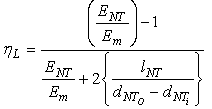 | (8) |
 | (9) |
where  and
and  are the length, volume, outer diameter and inner diameter of the multi-walled carbon nanotube.
are the length, volume, outer diameter and inner diameter of the multi-walled carbon nanotube.  is elastic modulus of matrix.Now, combine equation (1), (6) and (7), which will predict the elastic modulus of multi-walled carbon nanotube reinforced matrix composite in a random direction;
is elastic modulus of matrix.Now, combine equation (1), (6) and (7), which will predict the elastic modulus of multi-walled carbon nanotube reinforced matrix composite in a random direction; | (10) |
Since, MWCNT length is much shorter than the specimen thickness, the MWCNTs are assumed to be orientated in three dimensions and the orientation factor α is used. Therefore, again Halpin-Tsai equations 8 & 9 can be modified with orientation factor α as given below;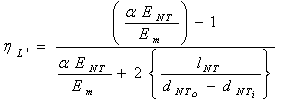 | (11) |
 | (12) |
Therefore, equation-10 can be re-modified with an orientation factor α and after the combination of equations 11 & 12, which will be predicted more accurate elastic modulus of MWCNT/epoxy resin composite, as expressed below; | (13) |
3. Experimental Study
3.1. Materials and Sample Preparation
Araldite (LY-556) 55%, hardener (HY-917) 49% and accelerator (DY-070) 0.28% were used as epoxy resin matrix. MWCNT filler was used as reinforcement in epoxy resin with weight percents 0.5, 1, 2 and 3%. Material properties are given in Table-1. Firstly, MWCNT particle was manually mixed with the resin (LY-556) with the variation of weight content and marked in batch-wise. | Table 1. Material properties |
| | Material | Geometry | Elastic modulus, GPa | | MWCNT | Length = ± 2 µmInner diameter = ± 6.5 nmOuter diameter = ± 40 nm | 1000.0 | | Epoxy resin | - | 2.0 |
|
|
MWCNT filled resin was dispersed using a lab-scale three-roll-mill (Exakt 120 EXAKT Advanced Technology GmbH, Germany), which enables the introduction of very high shear forces (up to 200,000 s-1) throughout the suspension. The pre-dispersed suspension was then given batch wise onto the roll with dwell times of 2 min. The dispersive forces on the suspension were acting in the gap (5 µm) between the rolls. After dispersion of the MWCNT in the resin LY-556, the hardener and accelerator were usually added in a vacuum dissolver, in order to avoid trapped air in the suspension. Then the mixture was placed in a vacuum chamber for 20 min to eliminate the bubbles introduced during the rolling process. The dispersed mixtures of MWCNT and resin were subsequently diluted by adding an appropriate amount of hardener (HY-917) in the weight ratio of 10:1. Again, MWCNT/epoxy resin mixture was dispersed by same method and remove air bubble completely from the mixture before curing. After curing, tensile and compressive specimens were prepared as per the ASTM standard for the measurement of mechanical properties.
3.2. Mechanical Tests
Mechanical properties of the MWCNT/epoxy resin composite were measured under tensile and compression loading. The shape and size of the specimens were prepared according to the ASTM standard[12]. The tensile specimen size (165 x 5.3 x 3 mm) was used in dog-bone shaped. The compression specimen size (25 x 7 x 6.5 mm) was used in short length to avoid the buckling effect. These tests were performed on the universal testing machine (UTM-5T; SC Deys & Company, Calcutta) with the cross-head speed of 0.05 mm/min. Load versus displacement results were used to measure elastic modulus under the tensile and compressive loading conditions. At least five specimens were tested for each sample with the variation of 10%. The tensile strength, compressive strength and elastic modulus are reported on average.
3.3. Microstructure Observation and Surface Analysis
The morphologies of the fractured specimens of MWCNT/epoxy resin composite were observed by scanning electron microscope (SEM) (High resolution SEM SUPRA 40, 5 kV, Zeiss, Germany).
4. Results and discussion
4.1. Mechanical Properties of MWCNT/Epoxy Resin Composite
To measure the influence of MWCNTs on the mechanical properties of epoxy resin matrix, the samples with specific size of composite were prepared according to the requirements of tensile and compressive tests. The tensile strength and compressive strength were calculated from the fracture loads.The results indicate that the tensile strength and compressive strength increases with increasing of weight percentage of MWCNT filler, as shown in Fig. 1. The probable reason is that a multi-walled carbon nanotube network structure is formed, which can take more mechanical loading from the matrix when the matrix is under stress[1]. This means that when the applied loading is over the elastic deformation stress, the multi-walled carbon nanotubes have a stress transfer effect, which can enhance the strength and plasticity of the resin matrix[4,12].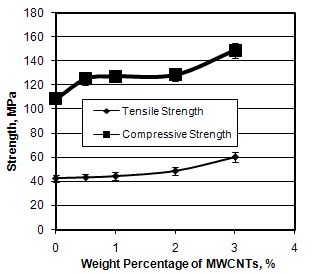 | Figure 1. Influence of MWCNTs on tensile and compressive strength |
Also, explanation of MWCNTs behavior can be found by considering the multi-branched morphologies of the interconnected-MWCNTs. The onset of the matrix cracking and the crack growth will be prevented as a result of mechanical joggling of the multi-branched morphologies.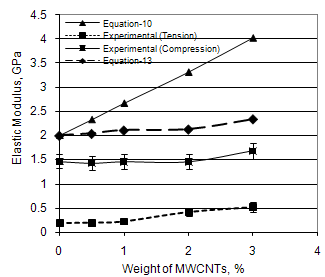 | Figure 2. Influence of MWCNT fillers on elastic modulus |
Comparing the compressive elastic modulus and tensile elastic modulus with the modified Halpin-Tasi model equation-10, the results show that the elastic modulus increases with the increasing MWCNTs content, as shown in Fig. 2. Experimentally determined compressive elastic modulus is 2 times lower than the calculated elastic modulus; whereas tensile elastic modulus is nearly 8 times lower than the predicted. It clearly indicates that the MWCNT filler try to resist the stress under compressive load, because carbon nanotubes produce more surface area of micro cracks due to bridges the crack surface, which increase the toughness of CNT/epoxy composite. Both results show a nonlinear increase in the elastic modulus values for the range of MWCNTs content. Again, Halpin-Tsai equation-10 can be modified by incorporating an orientation factor (α) to account for the randomness of discontinuous MWCNT filler, as given in equation-13. When the filler length is greater the specimen thickness, the fillers are assumed to be randomly oriented in two dimensions i.e., the orientation factor α = 1/3, when the filler length is much smaller than the thickness of the specimen, the fillers are assumed to be randomly oriented in three dimensions, i.e., the orientation factor α = 1/6[7]. The re-modified Halpin-Tsai equation-13 is presented better and closer results to the experimental results of compressive elastic modulus. Only, 27% variation is found in between calculated elastic modulus (equation-13) and compressive elastic modulus. However, re-modified Halpin-Tsai equation-13 is assumed to be for a uniform dispersion of the filler in the polymer matrix and perfect adhesion in between matrix and filler[12]. Also, elastic modulus of MWCNT/epoxy resin composite can be calculated on the basis of elastic modulus of MWCNT and neat epoxy resin. Therefore, it is believed that the difference between the theoretically predicted and experimentally obtained elastic modulus will be minimized under a more homogeneous dispersion and a better interface between the multi-walled carbon nanotube and the epoxy resin matrix[10,11]. Another reason for the observed difference is the development of voids produced during mixing of the hardener with the epoxy resin suspension through stirring[9]. Thus, the modulus of the material depends on the homogeneity of the dispersion. In the case of poor dispersion, though the composite elastic modulus is nearly the matrix modulus, clusters are regions of great modulus and high concentration of multi-walled carbon nanotubes. These great properties of particles are not transmitted to the solid due to the fact that nanotubes are agglomerated in a few regions of the solid instead of being uniformly dispersed throughout the whole matrix[3].
4.2. Morphology of fracture surface
The scanning electron microscope was used to observe the morphology of the tensile and compressive fracture surface of the specimens with higher resolution. Fig. 3 shows the compressive fracture surface of multi-walled carbon nanotube/epoxy resin composite. The surface shows a typical fracture pattern like brittle pattern in between the nanotubes. This indicates that the strong adhesion takes place in between MWCNT and epoxy resin and fractured in different planes[6]. Also, fracture surface is much rough and their crack becomes more random. This is probably because the crack expansion is blocked by the CNTs network and when the loading increases, the cracks will form in the weak area of the CNTs network. The multi-walled carbon nanotubes play an important role for pinning crack, and carry more external force. Furthermore, the carbon nanotubes are nano-scale units with high specific surface area.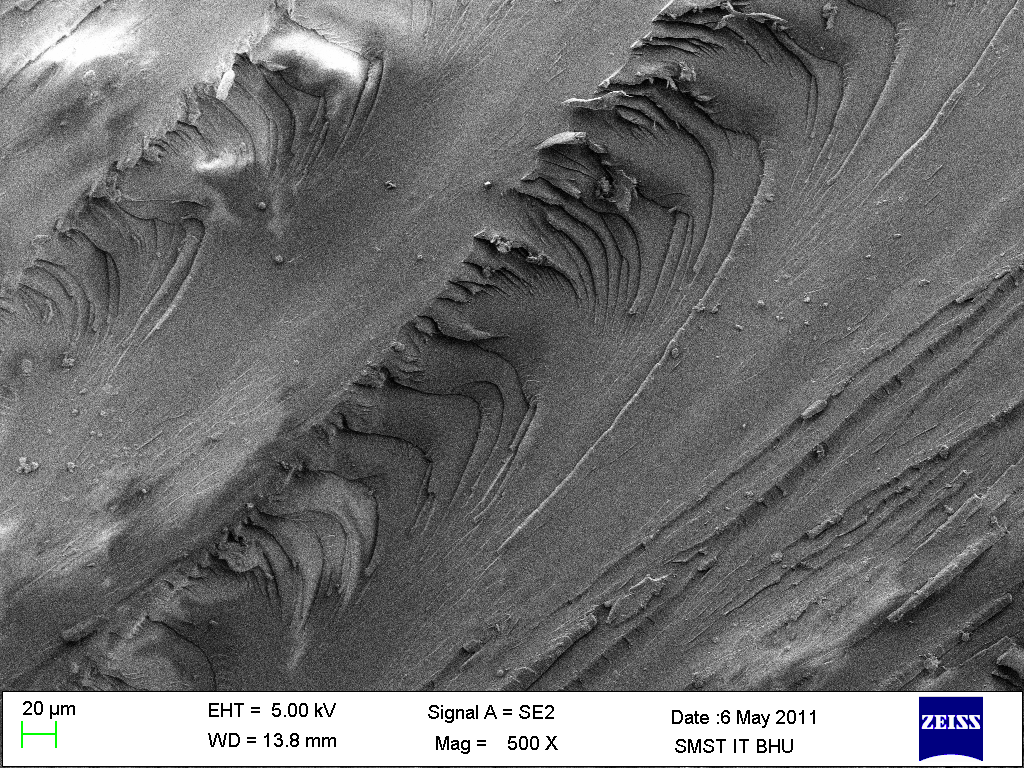 | Figure 3. SEM micrograph shows that cracks appeared in the epoxy resin reach area and propagated along MWCNTs interfaces at different planes under compressive load |
They have a firm connection and strong interaction with the matrix. So, the carbon nanotubes effectively, prevent the expansion of micro cracks resulted from the stress concentration and improve the strength of composites greatly[1,5]. On the other hand, when the content of MWCNTs is over certain content, the extra carbon nanotubes aggregate more seriously, and the CNTs dispersion becomes inhomogeneous in the matrix. 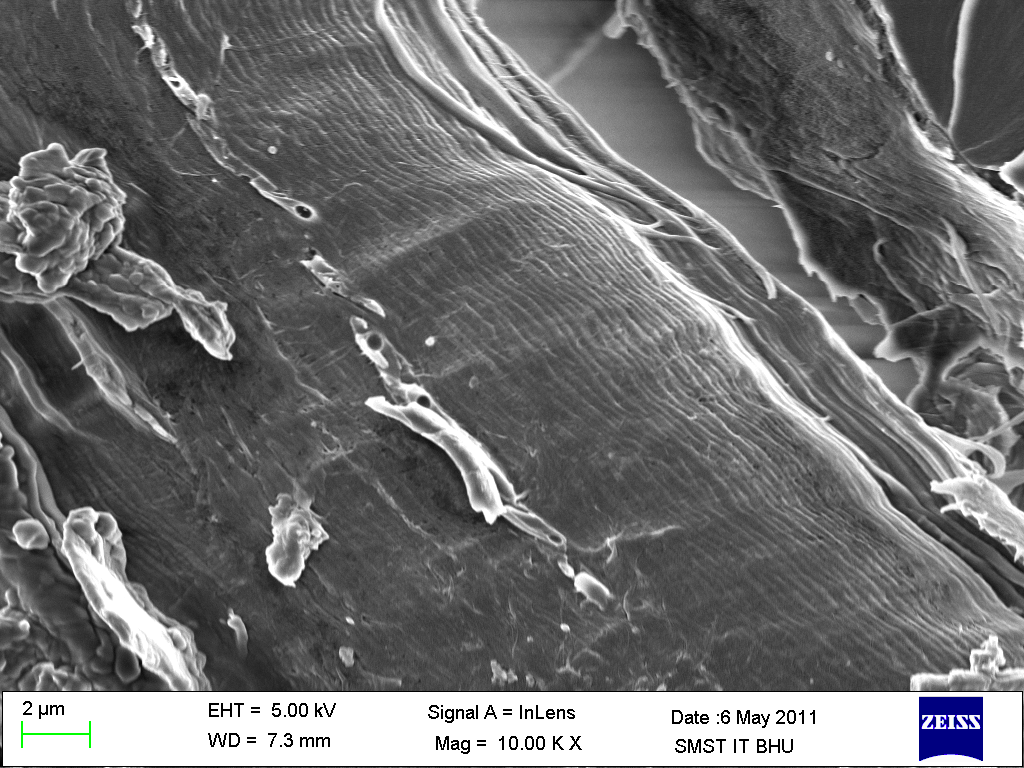 | Figure 4. SEM micrograph shows multi-walled carbon nanotube fractured and shrinkage along the length |
The network structure of CNTs disappears, the CNTs intertwine together to form a cluster in micro size, which will produce negative effects on the stress transfer from the matrix to the CNTs [4]. It is clear that CNTs fibre debonded from other fibres as well matrix, and then micro cracks diverted along epoxy resin side. Fig. 4 shows that the multi-walled carbon nanotubes gradually shrink and fractured with increase of compressive load because of buckling of fibre and bulging of tubes at the critical load. This indicate that MWCNT is burst out and separated from other tube, once maximum stress concentrated near by the weaker section, as shown in Fig. 5. | Figure 5. SEM micrograph shows multi-walled carbon nanotube burst-out and fractured |
In the SEM image with 500 magnifications, as shown in Fig. 6, the surface of MWCNTs is seen to be covered completely by epoxy resin, which indicates good adhesion between the epoxy resin and MWCNTs and results in better mechanical properties for the MWCNT/epoxy resin composite. This shows that MWCNTs pulled-out during tensile loading, which indicates the MWCNTs is not perfectly dispersed and bonded with the epoxy resin. 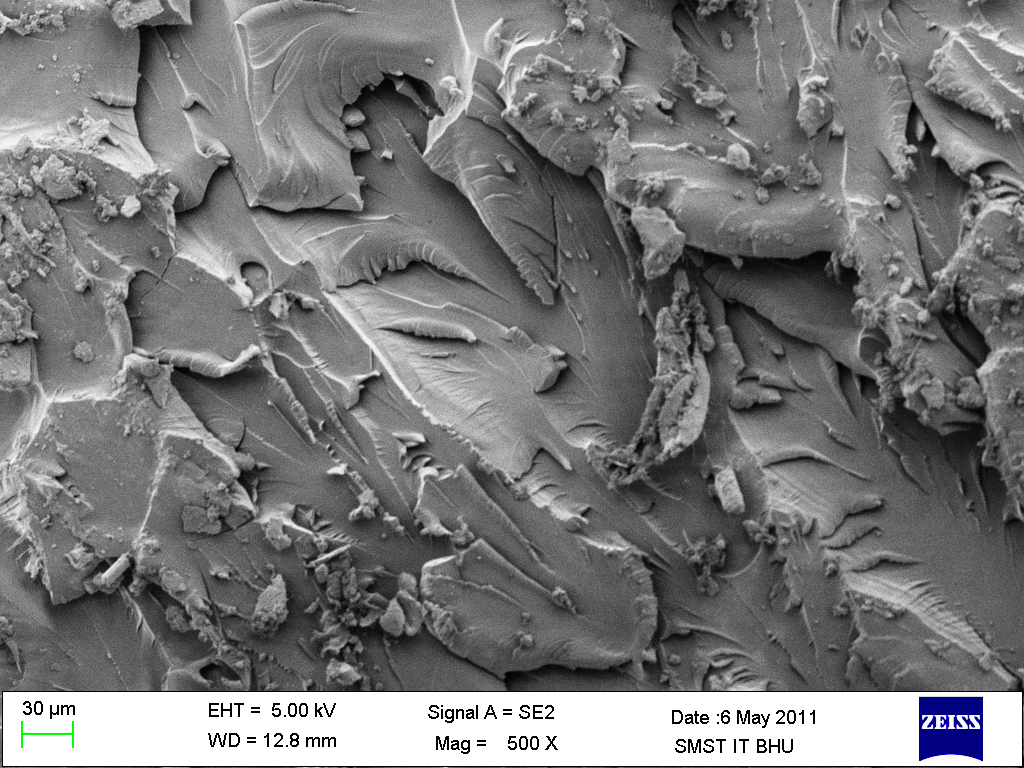 | Figure 6. SEM micrograph shows that maximum surface of MWCNTs covered with micro cracks of epoxy resin |
Based on the morphological images, one can observed that 3% multi-walled carbon nanotube increases the performance of pure epoxy resin because of resist the deformation of matrix. However, uniform dispersion and perfect adhesion of MWCNTs in the epoxy resin is the main reason to increase the properties of epoxy resin. Perfect interfacial bonding is fully transferring the effective stress from MWCNTs to epoxy resin. Pure epoxy resin generally fails in catastrophic mode, where as MWCNT filled epoxy resin fails in different pattern. In most cases, the crack started from the interface, and then MWCNTs suffered from the external force and were pulled out/broken, leaving the smooth resin matrix which exposed the weak interfacial bonding [11, 12]. This reveals that the great effect of MWCNTs surface groups on the interfacial bonding. Only, if MWCNTs firmly adhere to the epoxy resin, the load transfers from epoxy resin to the MWCNTs. Thus, the mechanical properties of epoxy resin have been improved with the addition of 3% MWCNTs because the stress concentration can be easily alleviated by the well –dispersed MWCNTs.
5. Conclusions
Multi-walled carbon nanotube/epoxy resin composite material was fabricated with the variation of weight percentage of MWCNT filler and their mechanical properties were investigated experimentally. The tensile strength, compressive strength, tensile elastic modulus and compressive elastic modulus increased with increasing of weight percentage of MWCNT content. When filler content 3%, these properties are increased by 29%, 28%, 13% and 60% respectively, compared with the neat epoxy resin.For the MWCNT/epoxy resin composite, a three dimensional orientation factor (α), was adopted to modify the Halpin-Tsai model, as given below;
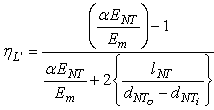 and
and 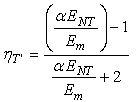 However, the experimental compressive elastic modulus can be fitted well by the modified Halpin-Tsai micro-mechanical model with the variation of 27%, which may be due to the effect of dispersion and in-homogeneity of the composites. Since, micro-mechanical model was developed for 100% dispersion and homogeneity of MWCNT/epoxy resin composite. SEM images of the fractured samples of 3% MWCNT/ epoxy resin composite gives good adhesion between the MWCNTs and the epoxy resin. This resulted that epoxy resin fractured in different planes with the perfect adhesive in between MWCNT contents. Also, it was observed that multi-walled carbon nanotube was buckled due to the strong interface before fractured under the compressive load.
However, the experimental compressive elastic modulus can be fitted well by the modified Halpin-Tsai micro-mechanical model with the variation of 27%, which may be due to the effect of dispersion and in-homogeneity of the composites. Since, micro-mechanical model was developed for 100% dispersion and homogeneity of MWCNT/epoxy resin composite. SEM images of the fractured samples of 3% MWCNT/ epoxy resin composite gives good adhesion between the MWCNTs and the epoxy resin. This resulted that epoxy resin fractured in different planes with the perfect adhesive in between MWCNT contents. Also, it was observed that multi-walled carbon nanotube was buckled due to the strong interface before fractured under the compressive load.
ACKNOWLEDGEMENTS
The authors would like to thank Institute of Polymer & Composites, TUHH, Harburg-Hamburg Germany, School of Materials Science & Technology, and Department of Mechanical Engineering, Institute of Technology, BHU, Varanasi, India for their supports.
References
| [1] | A. Allaoui, S. Bai, H.M. Cheng and J.B. Bai, Mechanical and electrical properties of MWCNT/epoxy composites, Compos Sci Technol, vol.62, pp.1993-1998, 2002 |
| [2] | V.K. Srivastava, Enhancement of elastic modulus of epoxy resin with carbon nanotubes, World J Nano Sci Eng, vol. 1(1), pp.1-6, 2011 |
| [3] | L. Ci and J. Bai, The reinforcement role of carbon nanotubes in epoxy composites with different matrix stiffness, Compos Sci Technol, vol.66, pp.599-603, 2006; 66 |
| [4] | F.H. Gojny, J. Nastalczyk, Z. Roslaniec and K. Schulte, Surface modified multi walled carbon nanotubes in CNT/epoxy composites, Chem Phys Lett, vol.370, pp.820-824, 2003 |
| [5] | W. Li, S.T. Buschhorn, K. Schulte and W. Bauhofer, The imaging mechanism, imaging depth, and parameters influencing the visibility of carbon nanotubes in a polymer matrix using an SEM, Carbon, vol.49, pp.1955-1964, 2011 |
| [6] | J.H. Lee, Y.K. Jang, C.E. Hong, N.H. Kim, P. Li and H.K. Lee, Effect of carbon fillers on properties of polymer composite bipolar plates of fuel cells, J Power Sources, vol.194, pp.523-529, 2009 |
| [7] | A. Montazeri, J. Javadpour, A. Khavandi, A. Tcharkhtchi and A. Mohajeri, Mechanical properties of multi walled carbon nanotubes/epoxy composites, Mater Design, vol. 31, pp. 4202-4208, 2010 |
| [8] | M.K. Yeh, N.H. Tai and Y.J. Lin, Mechanical properties of phenolic based composites reinforced by multi walled carbon nanotubes and carbon fibers. Compos Part A, vol. 39, pp.677-684, 2008 |
| [9] | B.X. Yang, J.H. Shi, K.P. Parmoda and S.H. Goh, Enhancement of the mechanical properties of polypropylene using polypropylene grafted multi walled carbon nanotubes, Compos Sci Technol, vol.68(12), pp. 1068-1114, 2008 |
| [10] | M.K. Yeh, T.H. Hsieh and N.H. Tai, Fabrication and mechanical properties of multi walled carbon nanotubes/epoxy composites, Mater Sci Eng A, vol.483-484, pp. 289-292, 2008 |
| [11] | M.K. Yeh, N.H. Tai and Y.J. Lin, Mechanical behavior of phenolic based composites reinforced with multi walled carbon nanotubes, Carbon, vol, 44, pp.1-9, 2006 |
| [12] | J. Zhang and D. Jiang, Interconnected multi walled carbon nanotubes reinforced polymer matrix composites. Compos Sci Technol, vol. 71, pp. 466-470, 2011 |
| [13] | R. Guzman de villoria and A. Miravete, Mechanical model to evaluate the effect of the dispersion in composites, Acta Materialia, vol. 55, pp. 3025-3031 |


 and
and  are the longitudinal and transverse elastic modulus respectively. Halpin-Tsai model applies for SWCNT (since length of SWCNT is shorter than the specimen thickness), which is written as given below[7];
are the longitudinal and transverse elastic modulus respectively. Halpin-Tsai model applies for SWCNT (since length of SWCNT is shorter than the specimen thickness), which is written as given below[7];

 and
and  take the following expressions;
take the following expressions;



 and
and  take the following expressions;
take the following expressions;

 and
and  are the length, volume, outer diameter and inner diameter of the multi-walled carbon nanotube.
are the length, volume, outer diameter and inner diameter of the multi-walled carbon nanotube.  is elastic modulus of matrix.Now, combine equation (1), (6) and (7), which will predict the elastic modulus of multi-walled carbon nanotube reinforced matrix composite in a random direction;
is elastic modulus of matrix.Now, combine equation (1), (6) and (7), which will predict the elastic modulus of multi-walled carbon nanotube reinforced matrix composite in a random direction;










 and
and  However, the experimental compressive elastic modulus can be fitted well by the modified Halpin-Tsai micro-mechanical model with the variation of 27%, which may be due to the effect of dispersion and in-homogeneity of the composites. Since, micro-mechanical model was developed for 100% dispersion and homogeneity of MWCNT/epoxy resin composite. SEM images of the fractured samples of 3% MWCNT/ epoxy resin composite gives good adhesion between the MWCNTs and the epoxy resin. This resulted that epoxy resin fractured in different planes with the perfect adhesive in between MWCNT contents. Also, it was observed that multi-walled carbon nanotube was buckled due to the strong interface before fractured under the compressive load.
However, the experimental compressive elastic modulus can be fitted well by the modified Halpin-Tsai micro-mechanical model with the variation of 27%, which may be due to the effect of dispersion and in-homogeneity of the composites. Since, micro-mechanical model was developed for 100% dispersion and homogeneity of MWCNT/epoxy resin composite. SEM images of the fractured samples of 3% MWCNT/ epoxy resin composite gives good adhesion between the MWCNTs and the epoxy resin. This resulted that epoxy resin fractured in different planes with the perfect adhesive in between MWCNT contents. Also, it was observed that multi-walled carbon nanotube was buckled due to the strong interface before fractured under the compressive load. Abstract
Abstract Reference
Reference Full-Text PDF
Full-Text PDF Full-text HTML
Full-text HTML